Submitted:
21 December 2023
Posted:
21 December 2023
You are already at the latest version
Abstract
Keywords:
1. Introduction
2. Materials and Methods
3. Results
3.1 Soil Morphology
3.2. Soil Physical Properties
3.3. Soil Chemical Properties
4. Discussion
Calcareous black soils
Hydromorphic black soils
Black soil on basalt
5. Conclusions
Author Contributions
Funding
Acknowledgments
Conflicts of Interest
References
- Han, X.; Li, N. Research Progress of Black Soil in Northeast China. Scientia Geographica Sinica 2018, 38, 1032–1041. [Google Scholar] [CrossRef]
- Song, C.; Lu, W.; Du, H. Degradation of Black Soil Quality and Strategies of Prevention Control in Northeast Plain, China. 2022. Available online: https://www.scitepress.org/Papers/2021/110203/110203.pdf.
- Andreeva, D.B.; Leiber, K.; Glaser, B.; Hambach, U.; Erbajeva, M.; Chimitdorgieva, G.D.; Zech, W. Genesis and properties of black soils in Buryatia, southeastern Siberia, Russia. Quaternary International 2011, 243, 313–326. [Google Scholar] [CrossRef]
- FAO. DEFINITION | What is a black soil? 2019. Retrieved 08 June 2023 from. Available online: https://www.fao.org/global-soilpartnership/intergovernmental-technical-panelsoils/gsoc17-implementation/internationalnetworkblacksoils/more-on-black-soils/definition-what-is-a-black-soil/en/.
- FAO Global status of black soils. Rome. 2022. [CrossRef]
- IUSSWorking Group, W.R.B. World Reference Base for Soil Resources. In International soil classification system for naming soils and creating legends for soil maps, 4th ed.; International Union of Soil Sciences (IUSS): Vienna, Austria, 2022. [Google Scholar]
- Soil Survey Staff Keys to Soil Taxonomy, 13th ed.; U.S. Department of Agriculture, Natural Resources Conservation Service: Washington, DC, USA, 2022.
- Sorokin, A.; Owens, P.; Láng, V.; Jiang, Z.-D.; Michéli, E.; Krasilnikov, P. “Black soils” in the Russian Soil Classification system, the US Soil Taxonomy and the WRB: Quantitative correlation and implications for pedodiversity assessment. CATENA 2021, 196, 104824. [Google Scholar] [CrossRef]
- Liu, X.; Burras, C.L.; Kravchenko, Y.S.; Duran, A.; Huffman, T.; Morras, H.; Studdert, G.; Zhang, X.; Cruse, R.M.; Yuan, X. Overview of Mollisols in the world: Distribution, land use and management. Canadian Journal of Soil Science 2012, 92, 383–402. [Google Scholar] [CrossRef]
- Smreczak, B.; Jadczyszyn, J.; Kabała, C. Przydatnoœć rolnicza rędzin w Polsce. Soil Science Annual 2018, 69, 142–151. [Google Scholar] [CrossRef]
- FAO. ITPS Status of the world’s soil resources (SWSR)–main report; Food and agriculture organization of the United Nations and intergovernmental technical panel on soils: Rome, Italy, 2015. [Google Scholar]
- Lal, R. Soil carbon management and climate change. Carbon Mgmt 2013, 4, 439–462. [Google Scholar] [CrossRef]
- Hag Husein, H.; Lucke, B.; Bäumler, R.; Sahwan, W. Contribution to Soil Fertility Assessment for Arid and Semi-Arid Lands. Soil Syst. 2021, 5, 42. [Google Scholar] [CrossRef]
- Achiba, W.B.; Gabteni, N.; Lakhdar, A.; Laing, G.D.; Verloo, M.; Jedidi, N.; Gallali, T. Effects of 5-year application of municipal solid waste compost on the distribution and mobility of heavy metals in a Tunisian calcareous soil. Agr. Ecosyst. Environ. 2009, 130, 156–163. [Google Scholar] [CrossRef]
- Parras-Alcántara, L.; Lozano-García, B.; Keesstra, S.; Cerdà, A.; Brevik, E.C. Long-term effects of soil management on ecosystem services and soil loss estimation in olive grove top soils. Sci. Total Environ 2016, 571, 498–506. [Google Scholar] [CrossRef]
- Muñoz-Rojas, M.; Jordán, A.; Zavala, L.M.; De la Rosa, D.; Abd-Elmabod, S.K.; Anaya-Romero, M. Organic carbon stocks in Mediterranean soil types under different land uses (Southern Spain). Solid Earth 2012, 3, 375–386. [Google Scholar] [CrossRef]
- Hag Husein, H.; Mousa, M.; Sahwan, W.; Bäumler, R.; Lucke, B. Spatial Distribution of Soil Organic Matter and Soil Organic Carbon Stocks in Semi-Arid Area of Northeastern Syria. Natural Resources 2019, 10, 415–432. [Google Scholar] [CrossRef]
- Ahmet, C. Soil organic carbon losses by water erosion in a Mediterranean watershed. Soil Research 2016, 55, 363–375. [Google Scholar] [CrossRef]
- Tarzi, J.G.; Paeth, R.C. Genesis of a Mediterranean red and a white rendzina soil from Lebanon. Soil science 1975, 120, 272–277. [Google Scholar] [CrossRef]
- Reifenberg, A. The Soils of Palestine, 2nd ed.; Thomas Murbery and Co.: London, UK, 1947. [Google Scholar]
- Durand, R.; Dutil, P. Experimental alteration of calcareous and dolomitic rocks-Importance of rock structure and its mineralogical nature. comptes rendus hebdomadaires des seances de l academie des sciences serie D 1971, 272, 2423. [Google Scholar]
- Geze, B. Carte de reconnaissance de sols du Liban. MinistCre de 1’Agriculture. In Direction de 1’Enseignement et de la Vulgarisation; Beyrouth: Rkpublique, Libanaise, 1956. [Google Scholar]
- Miklaszewski, S. Mémoire relatif à la Pologne, Mémoires sur la nomenclature et la classification des sols, Helsinki. 245-255, 1924.
- Sayegh, A.H.; Salib, A.J. Some physical and chemical properties of soils in the Beqa'a plain, Lebanon. Journal of Soil Science 1969, 20, 167–175. [Google Scholar] [CrossRef]
- Çepel, N. Sedir yetisme muhiti tanitinimin pratik esaslari ve orman yetisme muhiti haritaciligi; Kurtulus: Matbaasi, Istanbul, 1966. [Google Scholar]
- Darwish, T.M.; Zurayk, R.A. Distribution and nature of Red Mediterranean soils in Lebanon along an altitudinal sequence. Catena 1997, 28, 191–202. [Google Scholar] [CrossRef]
- Muir, A. Notes on the Soil of Syria. J. of Soil Sci 1951, 2, 163–187. [Google Scholar] [CrossRef]
- Nahal, I. Contribution à l'étude de la végétation dans le Baer-Bassit et le Djebel Alaouite de Syrie. Webbia 1962, 16, 477–641. [Google Scholar] [CrossRef]
- Nahal, I. The Mediterranean climate from a biological viewpoint. In: di Castri, Goodall W. and Specht, R. L. (eds): Mediterranean-type shrublands. Ecosystem of the World Vol. 11, Chapter 3. Elsevier Scientific Publishing Company. Amsterdam-Oxford-London: 63-86. 1981.
- Van Lier, W.J. Classification and rational utilization of soils. Report to the Govern. Syria; FAO: Rome, Italy, 1965; p. 141. [Google Scholar]
- Zain al Abdeen, A.N. Principles of soil science, University of Aleppo. 250-270, 1978.
- Chalabi, M.N. Analyse phytosociologique, phytoécologique, dendrométrique et dendroclimatologique des forêts de Quercus cerris subsp. pseudocerris et contribution à l’ étude taxinomique du genre Quercus L. en Syrie, Thèse de Doctrat ès -sciences, Université d' Aix- Marseille, France. III 342p. + annexes de 171 p. Ecologia Mediterranea T.VIII, (Fascicule 1/2). Marseille: 137-141. 1980.
- Ilaiwi, M. Contribution to the knowledge of the soils of Syria. Ph. D. Thesis, State Univ. Of Ghent, Belgium; p 259, 1983.
- Moormann, F. The soils of East Jordan: Report to the government of Jordan (Expanded Technical Assistance Program No. 1132). FAO, Rome, 1959.
- Ministry of Agriculture, Jordan (MoA). The Soils of Jordan: Level 1 (Reconnaissance Survey), Report of the National Soil Map and Land Use Project, Vol. 1, Ministry of Agriculture, Amman, Jordan, 1993.
- Ministry of Agriculture, Jordan (MoA). The soils of Jordan: Level 2 (Semi Detailed Studies), Report of the National Soil Map and Land Use Project, Vol. 3, Ministry of Agriculture, Amman, Jordan, 1995.
- Khresat, S.E.A. Nature and properties of mollisols in a semiarid region in northern Jordan. Communications in soil science and plant analysis 1999, 30, 2429–2436. [Google Scholar] [CrossRef]
- Lucke, B.; Schmidt, M.; al-Saad, Z.; Bens, O.; Hüttl, R.F. The Abandonment of the Decapolis Region in Northern Jordan – Forced by Environmental Change? Quaternary International 2005, 135, 65–81. [Google Scholar] [CrossRef]
- Lucke, B. Demise of the Decapolis. Past and Present Desertification in the Context of Soil Development, Land Use, and Climate. Omni Scriptum, Saarbrücken. First published online in 2007, dissertation at BTU Cottbus, 2008.
- Lucke, B.; Kemnitz, H.; Bäumler, R. Evidence for isovolumetric replacement in Terrae Rossae of Jordan. Boletin de la Sociedad Geologica Mexicana 2012, 64, 21–35. [Google Scholar] [CrossRef]
- Emberger, L. Une classification biogeographique des climates. Recueil trav. Lab. Bot. Geol. Zool. Fac. Sci. Montpellier. 1955, 7, 3–43. [Google Scholar]
- Soil Survey Division Staff Soil Survey Manual. U. S. Dept. Of Agric.Handb.18.U. S. Covt. print Off. Washington, D. C; p 510, 1993.
- U.S.D.A-NRCS Field Book for Describing and Sampling Soils. v 1.1. USDA. Lincoln, Nebraska. p 182, 1998.
- Walkley, A.; Black, A. An examination of the Degtjareff method for determining soil organic matter and a proposed modification of the chromic acid titration method. Soil Sci. 1934, 37, 29–38. [Google Scholar] [CrossRef]
- Nelson, D.W.; Sammers, L.E. Total carbon and organic matter. In A. L. Page, R. H. Miller, and D. R. Keeney (eds) Methods of soil analysis, Part 2. Chemical and microbiological properties. Agronomy Monograph no. 9 (2end edition), S. Segor Dd; ASA-SSSA, Madison, USA. 539-579, 1982.
- Soil Survey Staff Soil taxonomy: a basic system of soil classification for making an interpreting soil survey. U. S. Department of Agriculture. Habdb. 436. U.S. Govt. Print. Washington, D. C; p 503, 1975.
- Soil Conservation Service. Soil Survey laboratory methods. Soil Survey. Invest. Report No 42; U. S. Dept. Agric; Washington, D. C; p 400, 1992.
- Mehlich, A. Use of Triethanolamine Acetate-Barium Hydroxide Buffer for the Determination of Some Base Exchange Properties and Lime Requirement of Soil 1. Soil Science Society of America Journal 1939, 3, 162–166. [Google Scholar] [CrossRef]
- Turski, R.; Domżał, H.; Borowiec, J.; Flis-Bujak, M.; Misztal, M. Gleboznawstwo. Ćwiczenia dla studentów wydziałów rolniczych. Wyd. Nauk. PWN, Warszawa, 1-278, 1986.
- Kjeldahl, J. Neue Methodezur Bestimmung des Sticksoffs in organischen Körpern. Z. Anal. Chem 1883, 22, 36–382. [Google Scholar] [CrossRef]
- McRae, S.G. Practical pedology studying soils in the field. Ellis Horwood Limited: Chichester, UK, 1988; p. 253. ISBN 0-85312-918-5. [Google Scholar]
- Olsen, S.R.; Cole, F; Watanabe, S.; Dean, L.A. Estimation of available Phosphorus in soil by extraction with sodium bicarbonate. U. S. Department of Agriculture Circular 939, Washington, D C. p 18, 1954.
- Jackson, M.L. Instrument in soils and waters. J. Agric. Food Chem. 1956, 4, 602–605. [Google Scholar] [CrossRef]
- Arnold, R.W. Multiple Working Hypothesis in Soil Genesis 1. Soil Science Society of America Journal 1965, 29, 717–724. [Google Scholar] [CrossRef]
- Lucke, B.; Hag Husein, H.; Sahwan, W.; Bäumler, R. A preliminary survey of soils and sediments in the Dead Cities region, northwestern Syria. In: Riis, T. ed., The “Dead Cities” of Northern Syria and Their Demise, Verlag Ludwig, Kiel, 33-59, 2015.
- Erdağ, A; Kirmaci, M.; Tizini, I.; Kashlan, A.; Addine, B.C. Contributions to the moss flora of the Al-Ghab plain (north-west Syria). Turkish Journal of Botany 2013, 37, 369–374. [Google Scholar] [CrossRef]
- Hag Husein, H.; Kalkha, M.; Al Jrdi, A.; Bäumler, R. Urban Soil Pollution with Heavy Metals in Hama Floodplain, Syria. Natural Resources 2019, 10, 187–201. [Google Scholar] [CrossRef]
- Technoexport. The geological map of Syria. Scale 1:1,000,000. Explanatory notes. Ministry of Industry, Syria, 111p, 1966.
- Hag Husein, H.; Nammora, T.; Zaghtiti, I.; Al-Khateeb, A.; Zenyah, E. Soil Catena Properties of Daher Al-Jabal IN south Syria. International Journal of Environment 2017, l6, 87–107. Available online: http://www.nepjol.info/index.php/IJE/article/view/16870/13714. [CrossRef]
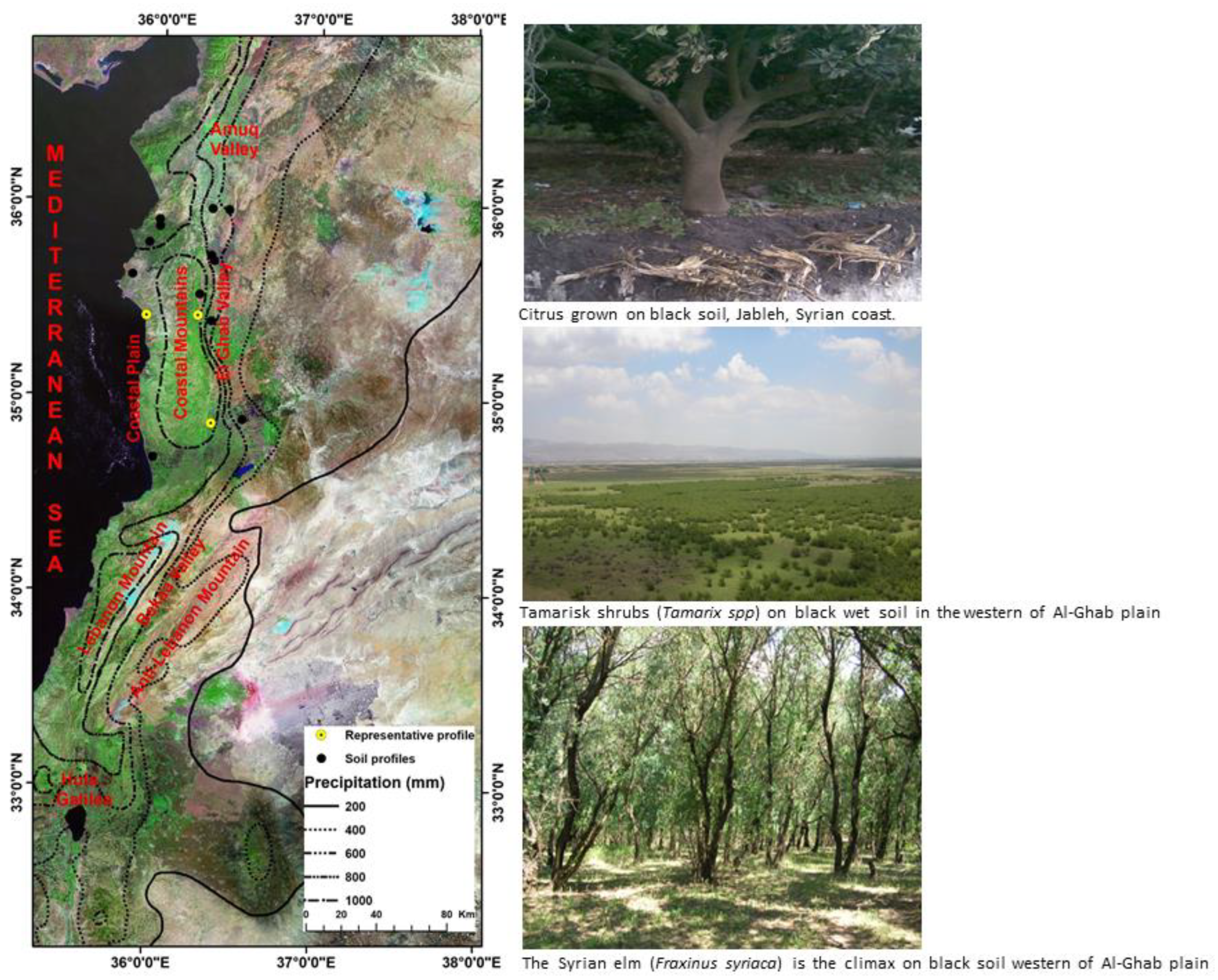
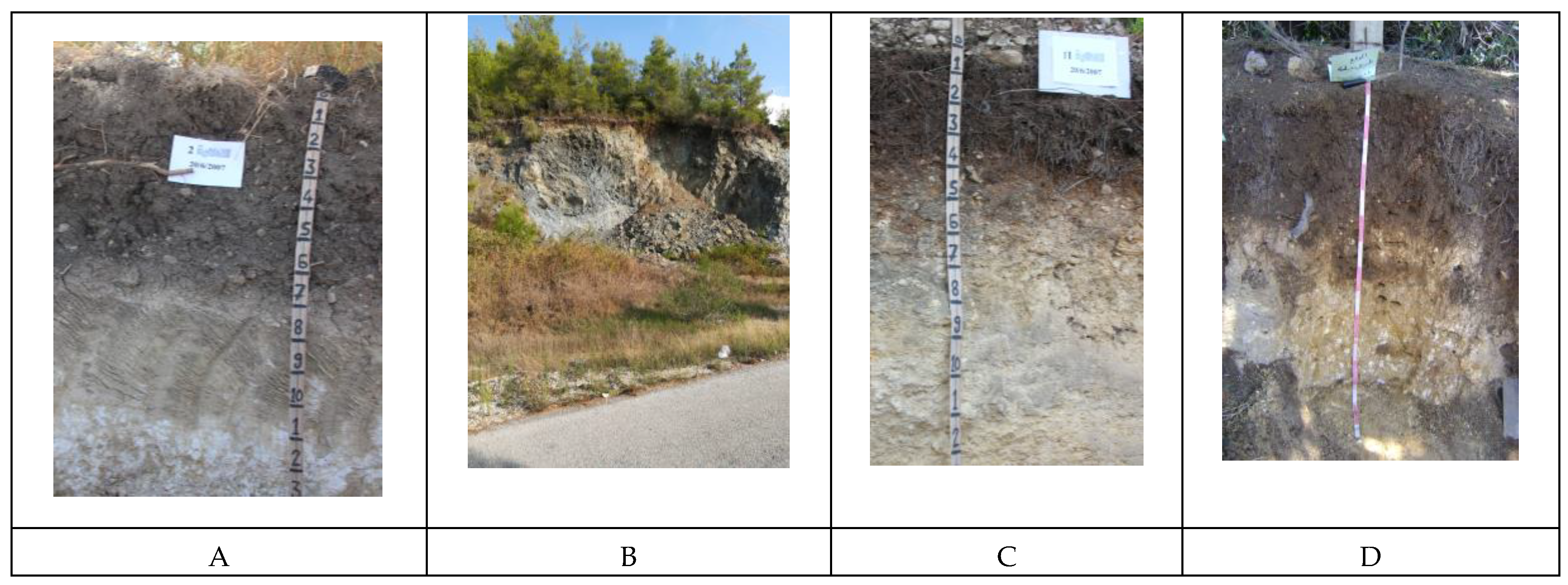
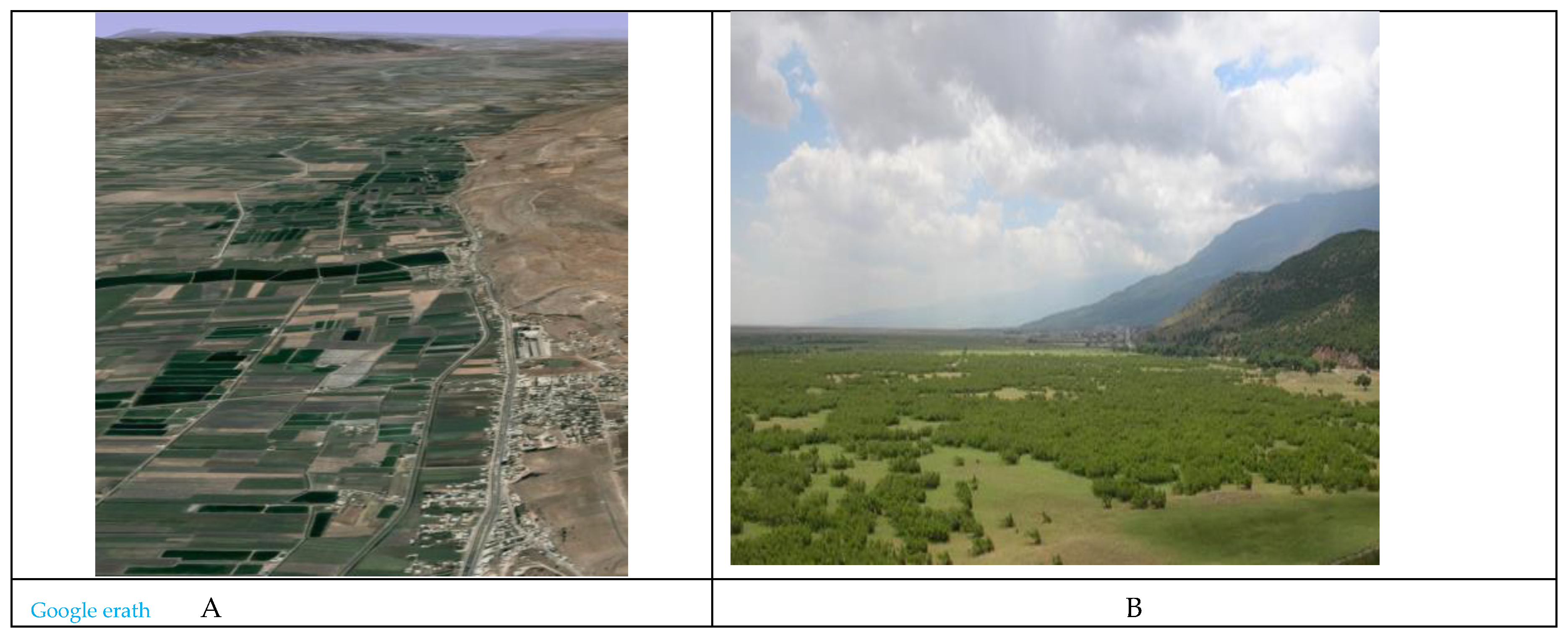
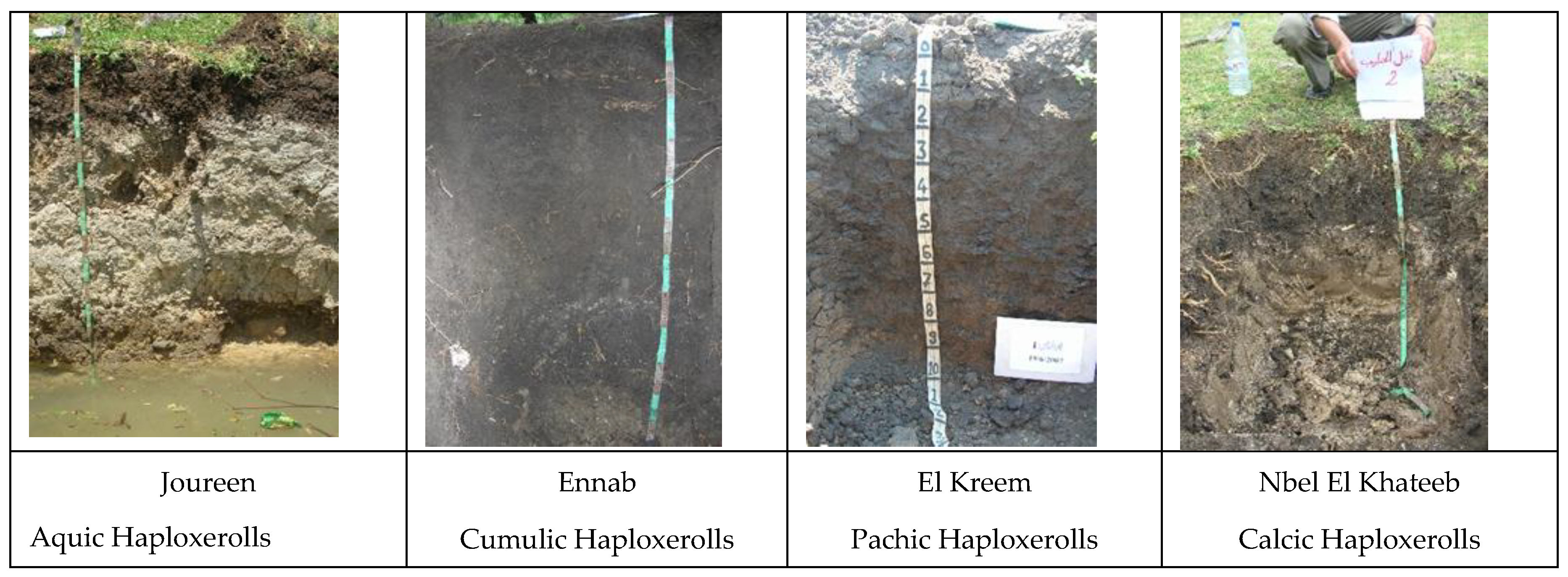
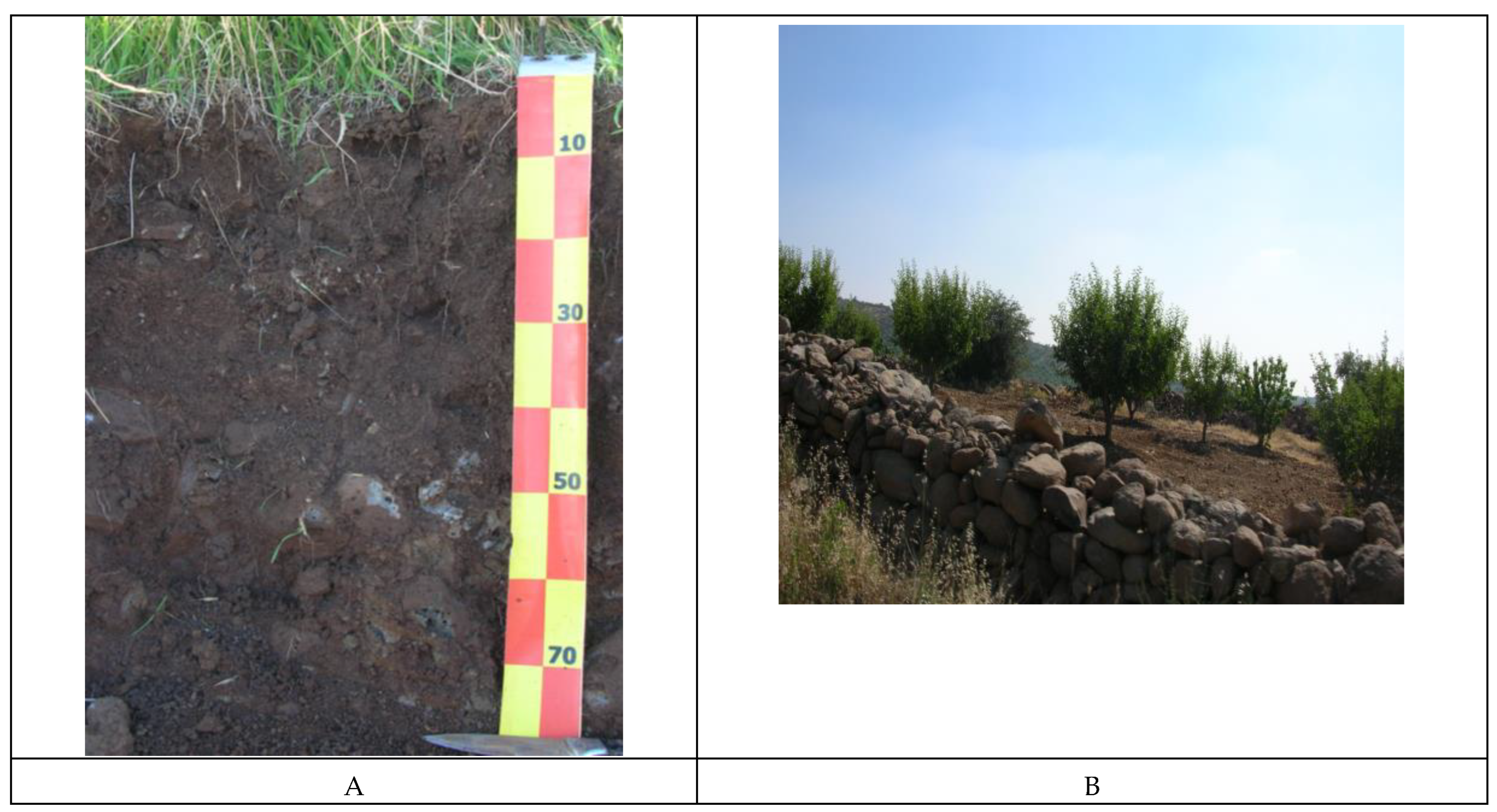
| Profile Cod |
Coordinates & Elevation |
Rainfall mm |
Bio-climate zone | Physiography & Topographic position |
Drainage class | Vegetation | Parent material | Classification | |
|---|---|---|---|---|---|---|---|---|---|
| ST | WRB | ||||||||
| Jableh |
35°25'10.67" N 35°55'23.37" E 28 m. a. s. l |
863 | Sub-humid hot | littoral undulating plain, very gently slope towards east | moderately well drained, very slow surface run off | pine trees | calcareous sandstone and conglomerates | Typic Rendolls | Rendzic Leptosols |
| Al Qanjra | 35°37'43.7" N 35°49'40.13" E 10 m. a. s. l |
797 | Sub-humid hot | littoral flat plain, very gently slope towards east | moderately well drained, very slow surface run off | cultivated olive trees | Pliocene marls and limestone | Typic Calcixerolls | Somerirendzic Leptosols |
| Kassab-Zanzaf | 35°47'44.77" N 35°55'46.52" E 240 m. a. s. l |
1248 | humid temperate | littoral high hilly areas foot slopes | well drained, rapid surface run-off, moderately slow permeability | pome trees | undifferentiated complex of igneous rock predominated by serpentine of Mesozoic era | Typic Rendolls | Rendzic Leptosols |
| Kasab Nibh Almur |
35°52'41.93"N 35°59'35.60"E 380 m. a. s. l |
1248 | humid temperate | littoral high hilly areas middle slopes of mountainous area | well drained, rapid surface run-off, slow permeability | pome trees and stone fruit trees | undifferentiated complex of igneous rock predominated by serpentine of Mesozoic era | Entic Ultic Hapoloxerolls | Rendzic Leptosols |
| Kassab | 35°54'47.54"N 35°59'24.10"E 800 m. a. s. l |
1248 | humid temperate | littoral high hilly areas middle slopes of high hills | well drained, rapid surface run-off, moderately rapid permeability | pome trees | undifferentiated complex of igneous rock predominated by serpentine of Mesozoic era | Entic Ultic Hapoloxerolls | Rendzic Leptosols |
| Der Autman | 35°58'22.8" N 36°19'16.2" E 325 m. a. s. l |
679 | sub-humid temperate | Inland mountainous area –backslope of undulating hills |
well drained | cultivated olive and stone fruit trees | limestone | Calcic Pachic Hapoloxerolls | Leptic Kastanozem |
| Drkosh-Al-daher | 35°58'04.8" N 36°25'37.9" E 530 m. a. s. l |
679 | sub-humid temperate | littoral high hilly areas mountainous area | well drained | shrubs and cultivated olive tress | dolostones and hard limestone | Entic Hapoloxerolls | Rendzic Humic Leptosol |
| Akkar-Zahed | 34°41'38.66"N 35°59'12.36"E 1 m. a. s. l |
1150 | sub-humid hot | littoral plain -flat plain | poorly drained, very slow surface runoff, slow permeability | irrigated vegetable and greenhouses | quaternary and recent colluvium and alluvium derived mainly from neogene basalt | Vertic Haploxerolls |
Vertic Chernozems |
| Barshin | 34°52'20.60"N 36°20'37.41"E 930 m. a. s. l |
994 | humid temperate | littoral high hilly - backslopes of high hills |
moderately well drained, rapid run-off, slow permeability | pome trees | Pliocene basalt | Typic Haploxerolls |
Somerirendzic Leptosols |
| Houla | 34°53'42.88"N 36°32'11.59"E 375 m. a. s. l |
480 | semi-arid temperate | Historical oasis -level flood plain | somewhat poorly drained | field crops and irrigated vegetables | alluvial deposits of quaternary to more recent era, derived mainly from neogene basalt | Aquic Haploxerolls | Vertic Kastanozems |
| Al-Ghab-Joureen | 35°31'58.92"N 36°15'7.67"E 183 m. a. s. l |
871 | sub-humid temperate | rift valley-level to depressional valley fills | moderately well drained, very slow surface run-off, slow permeability | elms trees | quaternary or more recent marl diatomaceous lacustrine deposits | Aquic Haploxerolls | Leptic Chernozems |
| Al-Ghab-Ennab | 35°25'25.40" N 36°14'41.89" E 182 m. a. s. l |
871 | sub-humid temperate | rift valley-level to depressional valley fills | moderately well drained, very slow surface run-off, slow permeability | elms trees | quaternary or more recent marl diatomaceous lacustrine deposits | Aquic Haploxerolls | Vermic Chernozems |
| Al-Ghab-Al Kareem | 35°23'48.30" N 36°19'49.73" E 178 m. a. s. l |
695 | sub-humid temperate | rift valley-level to depressional valley fills | moderately well drained, very slow surface run-off, slow permeability | irrigated agriculture | quaternary or more recent marl diatomaceous lacustrine deposits | Patchic Haploxerolls | Haplic Chernozems |
| Al-Ghab-Qarqor | 35°43'58.76"N 36°19'13.47"E 170 m. a. s. l |
679 | sub-humid temperate | rift valley-level to depressional valley fills | moderately well drained, very slow surface run-off, slow permeability | irrigated agriculture | quaternary or more recent marl diatomaceous lacustrine deposits | Patchic Haploxerolls | Haplic Chernozems |
| Al-Ghab-Mshik | 35°42'20" N 36°20'26.7" E 175 m. a. s. l |
693 | sub-humid temperate | rift valley-level to depressional valley fills | moderately well drained, very slow surface run-off, slow permeability | irrigated agriculture | quaternary or more recent marl diatomaceous lacustrine deposits | Patchic Haploxerolls | Haplic Chernozems |
|
Hor-izon |
Depth (cm) |
Color | Structure | Consistence | Pores | Roots | Boundary | Special features | |
| dry | wet | ||||||||
| Jableh | |||||||||
| Oi | 5-0 | very dark gray 10YR 3/1 | black 10YR 2/1 | midrate medium fine granular | slightly plastic | - | abundant very fine to medium | abrupt smooth | slightly decomposed plant materialfrequent rounded stone constituting approximately 10% |
| A | 0-35 | - | very dark grayish brown 10 YR 3/2 | weak fine granular | sticky and plastic | few very fine and fine discontinuous irregular simple open | few fine and very fine | clear wavy | roots mostly inside peds |
| A2 | 35-50 | dark red 2.5Y3/6 | - | fine granular | sticky and plastic | Few fine vertical in ped simple closed | few fine | very abrupt smooth | Few small soft carbonate stones |
| C | 50+ | - | very pale brown10YR8/2 and pink 7.5YR8/3 | - | - | - | - | - | Conglomerates calcareous sandstone |
| Al-Ghab | |||||||||
| A | 0-26 | dark brown 10 YR 3/3 | black 10 YR 2/1 | midrate medium granular | soft (dry) slightly firm (moist) sticky and plastic | many fine horizontal in ped simple open | plenty fine | abrupt smooth | roots between peds |
| A2 | 26-55 | - | very dark brown 10 YR 3/2 | fine granular | firm (moist) sticky and plastic | few fine vertical in ped simple closed | Plenty fine | gradual wavy boundary | Roots between peds |
| AC | 55+ | - | grayish brown 10 YR 4/1 | massive | firm (moist) sticky and plastic | few fine vertical in ped simple closed | few fine inside peds | - | few small soft carbonate accumulations on ped faces |
| Barshin | |||||||||
| Ap | 0-18 | dark brawn 10 YR 3/3 | very dark grayish brawn10YR 3/2 | moderate medium subangular blocky breaking to moderate firm granular | very hard (dry) firm (moist) sticky and plastic | fine and medium dis-continuous vertical open | few fine | clear smooth | De-rocking surface |
| A2 | 18-40 | dark brawn 10 YR 3/3 | very dark grayish brawn10YR 3/2 | moderate medium subangular blocky | very hard (dry) firm (moist) | few fine dis-continuous vertical open | few fine and medium | clear smooth | few subrounded gravel 10% |
| C | 40-75 | - | Very dark grayish brawn 10 YR 3/2 | weak medium subangular blocky | very hard (dry) firm (moist) | Few fine dis-continuous open | few medium and coarse | broken | Soil and partially weathered parent material |
| R | 75+ | Neogene Basalt | |||||||
| Soil | Horizon | Depth (cm) | Particle size distribution (%) Ø mm | Clay/Sand | Clay/Silt | Texture | ||
| Sand | Silt | Clay | ||||||
| Jableh | Oi | 0-5 | 54 | 16 | 30 | 0.55 | 1.87 | sandy clay loam |
| A | 5-35 | 60 | 14 | 26 | 0.43 | 1.85 | clay loam | |
| A2 | 35-50 | 46 | 22 | 32 | 0.69 | 1.45 | Sandy clay loam | |
| C | 50+ | 40 | 40 | 20 | 0.5 | 0.5 | sandy clay loam | |
| Al-Ghab | A | 0-26 | 46 | 26 | 28 | 0.6 | 1.07 | sandy clay loam |
| A2 | 26-55 | 48 | 34 | 18 | 0.37 | 0.69 | loam | |
| AC | 55+ | 46 | 24 | 30 | 0.65 | 1.25 | sandy clay loam | |
| Barshin | Ap | 0-25 | 12 | 42 | 46 | 3.83 | 1.09 | clay |
| A2 | 25-55 | 12 | 39 | 49 | 4.08 | 1.25 | clay | |
| AC | 55-115 | 12 | 39 | 49 | 4.08 | 1.25 | clay | |
| R | 115+ | - | - | - | - | - | - | |
| Horizon |
Depth (cm) |
pH | Carbonates as CaCO3% | EC mS.m_1 | C org. % | Extractable bases meq.100g-1 |
Ext. P2O5 mg.kg-1 | Tot. N % | CEC meq.100g-1 |
BS | |||||
|---|---|---|---|---|---|---|---|---|---|---|---|---|---|---|---|
| CaCl2 1:1 |
H2O 1:1 |
<2mm | <0.002mm | Ca++ | Mg++ | K+ | Na+ | ||||||||
| Jableh | |||||||||||||||
| Oi | 0-5 | 7.42 | 7.54 | 2.2 | ND | 0.5 | 4.42 | ND | ND | 0.4 | 0.3 | 31.3 | 0.38 | 52.5 | 100 |
| A | 5-35 | 7.64 | 7.8 | 16.4 | ND | 0.4 | 2.41 | ND | ND | 0.1 | 0.3 | 20.5 | 0.19 | 62.5 | 100 |
| A2 | 35-50 | 8.1 | 8.2 | 29.5 | ND | 0.4 | 0.9 | ND | ND | 0.2 | 0.4 | 29.0 | 0.08 | 67.9 | 100 |
| C | 50+ | 7.42 | 7.54 | 44.0 | ND | 0.5 | 0.1 | ND | ND | 0.2 | 0.3 | 19.0 | - | 70.2 | 100 |
| Al-Ghab | |||||||||||||||
| A | 0-26 | 7.23 | 41.0 | 17.0 | 1.6 | 4.2 | 28.0 | 8.0 | 0.2 | 0.9 | 11.8 | 2* | 42 | 88.2 | |
| A2 | 26-55 | 7.86 | 69.5 | 27.0 | 2.1 | 3.1 | 15.0 | 1.1 | 0.1 | 1.1 | 8.2 | 4* | 24 | 88.3 | |
| AC | 55+ | 7.64 | 77.0 | 26.0 | 2.5 | 2.2 | 11.0 | 0.6 | 0.1 | 0.6 | 3.3 | 2* | 22 | 75.7 | |
| Barshin | |||||||||||||||
| Ap | 0-18 | 5.6 | 5.8 | 2.0 | 3.2 | 0.3 | 1.8 | 18.7 | 8.5 | 2.02 | 0.24 | 4.1 | 1.5* | 32.8 | 67.9 |
| A2 | 18-40 | 5.5 | 5.6 | tr | 4.3 | 0.4 | 1.1 | 19.9 | 8.9 | 1.14 | 0.24 | 3.9 | 1.2* | 32.6 | 72.4 |
| C | 40-75 | 5.8 | 6.1 | 1.0 | 9.8 | 0.8 | 0.6 | 21.6 | 9.3 | 0.56 | 0.22 | 3.5 | 0.9* | 33.1 | 88.3 |
| R | 75+ | - | - | - | - | - | - | - | - | - | - | - | - | - | - |
Disclaimer/Publisher’s Note: The statements, opinions and data contained in all publications are solely those of the individual author(s) and contributor(s) and not of MDPI and/or the editor(s). MDPI and/or the editor(s) disclaim responsibility for any injury to people or property resulting from any ideas, methods, instructions or products referred to in the content. |
© 2023 by the authors. Licensee MDPI, Basel, Switzerland. This article is an open access article distributed under the terms and conditions of the Creative Commons Attribution (CC BY) license (http://creativecommons.org/licenses/by/4.0/).





